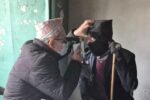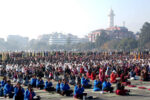The term tourism has become common parlance to most of the conscious people across the globe. It is to the selling of dreams. Making Nepal a tourist recreation destination has been a purpose for all Nepalis who regard tourists as Gods, ‘Atithi Deva Bhava’.
Tourism is one of the most potential areas for development. Moreover, Nepal’s development is not possible sans rural development. Since rural poverty cannot be alleviated without economic development, rural tourism can play a key role in its development.
Nepal is a destiny for tourists who desperately try to explore nature. The country boasts of several such unique areas to be explored which are equally luring to pioneers and connoisseurs of tourism.
Nepal’s unique villages, including natural gifts, biodiversity, and ethnocultural heritages play a significant role to promote tourism. It is an explicit concept that affluent and conscious people harness the gifts to achieve maximum benefit out of them. The dimensions of needs vary from individuals, perhaps according to the capacity and the extent of the resources. Therefore, the basic prerequisite of tourism industry trades off the needs between the affluent and the needy.
Nepal is a destiny for tourists who desperately try to explore nature. The country boasts of several such unique areas to be explored which are equally luring to pioneers and connoisseurs of tourism.
A tourist is a person who travels for the sake of curiosity or for fun away from home to experience a change. They are also defined as persons who travel to learn, fall in love with nature, to relax and to enjoy the socio-cultural setting outside their region.
Today, tourism is particularly related to the economic development of an individual, society and the nation. It is equally beneficial to the hosts and the guests. Mutually who gets in what quantities and qualities in the exchange are determined by the capacity of the party who is involved in it. The fundamental premises of tourism development are based on the demand and supply driven mechanism.
Village tourism can be based on some particular areas, locality settlement and villages with their typical peculiarity because a village possesses varieties or specialties.
Over a couple of years, Nepali scholars, development planners, policymakers and tourism entrepreneurs have taken interest in village tourism which is also known as community-based tourism. It may not be unusually weary of them to prosper the country life of ours where the majority (85%) of the people spend their lives based on 76% agro-occupation.
The rural areas and lives of Nepali people bank on a huge tourism resource. It can be a good market for domestic, regional (SAARC countries plus China) as well as international tourists. Village tourism can be one of the viable contributing factors for the nation’s development. It is an income generating activity where people living in poverty will have employment opportunities.
Village tourism can be based on some particular areas, locality settlement and villages with their typical peculiarity because a village possesses varieties or specialties. To cite few examples– fish items of Rani Pouwa and Malekhu, hot spring water bath of Myagdi, Shambala trek and Bhot culture of Humla, Ranighat Durbar- Palpa, Fikal Tea-estate- Illam, Nagarkot and Daman for sightseeing, Manakamana for pilgrimage and cable car, Sedibeni- Parbat for rafting, boating and pilgrimage, Raute people (nomad), typical Gurung culture of Ghalegaon and Sirubari, etc.
Nepal has no acuteness of resources and opportunities for tourism development. It can be the backbone of the country’s economy and an important measure to fight against rural poverty. Tourism potentialities are mostly unexplored, minimum in use or not brought at the screen of dissemination.
Israel has unique family-visit tourism. Students in Israel prefer traveling. Tourists are guided to the agro-farm, local products, dairy farm, and are acquainted with the rural life setting
By nature, tourism is defined as “traveling for recreation”. Who does travel? The affluent who possesses money and is in leisure. The term ‘recreation’ ranges and covers a wide area and items of pleasure. Therefore, a tourist spot must meet the aim and desires of the tourists such as pleasing weather, scenic attraction, historical and archaeological heritage, cultural treasures, accessibility, amenities, accommodation, hospitality, biological and psychological desires.
As China observed 2005 as the Year of Red Tourism for the economic development of rural areas, Nepal, too, can do that. In European countries, village tourism is in prosperity. In Austria, many village communities run small cottages, inns, and guest rooms and tourists are provided with bed and breakfast. In Israel, the cooperative (Kibbutz and Moshav) sponsors and manages village tourism.
Israel has unique family-visit tourism. Students in Israel prefer traveling. Tourists are guided to the agro-farm, local products, dairy farm, and are acquainted with the rural life setting. Local products are sold as souvenirs. Therefore, there is a high potentiality to develop a rural-urban linkage for rural development.
Even though Nepal has immense prospects of village tourism, the country will not be able to exploit the treasury of it for the time being since barring a few urban dwellers, one cannot afford the money, time and attention. It is evident that we the Kathmanduties have initiated village tourism at the vicinity, adjacent localities of the valley and gone beyond to Sauraha, Ghandruk, Ghalegaon, Kakani, and Manakamana.
Most middle-level income people opt for such destinations. Therefore, whenever the economy of middle-level people increases, the volume of village tourism prospers. Government’s measure for Tourism for Rural Poverty Alleviation Program (TRPAP), which started in six districts, can be regarded as pro-poor tourism.
It has tried to directly link with rural poverty. Few sites are selected as pilot project destinations. The plan needs an action plan with specific programs based on the entrepreneurs’ need. As a facilitator, the government should build forward and backward linkages network. Nepal Tourism Board (NTB) can do more than what it is designated today in the days ahead. But the role of the private sector is more important than that of government.
The Tenth Plan also stresses the tourism sector as an important instrument of poverty reduction. But a public-private partnership program is highly desirous. A collective effort is required. The convergence of need and capacity of both the locals and the tourists is expected where a win-win situation is likely. Though Nepal has a good prospect of tourism, the following constraints should be considered: First, more than one-third of the total population is under the poverty line. Most village tourism potential areas are beyond the accessibility of domestic tourists. Second, the affluent rarely have leisure time and those having leisure does not have enough money, i.e. the level of economic condition is adverse.
Third, political instability or poor governance, and apathetic culture are the main impediments of the development. Fourth, the specialty and identity of village tourism destinations are mostly unexplored or half-explored, inaccessible and are underdeveloped. Fifth, the government has an insufficient plan, policies, and programs regarding the promotion of village tourism. Sixth, urban center oriented development plan and priorities of the government tend to urban migration; consequently, most ethnic cultures, feasts, and festivals, ceremonies, and celebrities are urbanized as well as faked.
Seventh, the awareness level of the locals is very low and cannot identify themselves and use resources around them. Eighth, conservative social structure, traditional concept and legacy, parochial culture, social taboos and slow impact of advanced cultures are some of the challenges to this regard, Ninth, there is inadequate information dissemination and communication i.e. ads and publicity, among others.
Thus, village/community tourism is a meso tourism concept evolved lately in the tourism world. Nepal can be a model destination since this country possesses multi-faceted potentialities. Natural gifts, man-made heritages, ethnocultural richness, innocent social setting and hospitality, and many more unexplored treasures are dreams for connoisseurs of tourism.
Village tourism cannot prosper sans the convergence of needs of the affluent and the needy based on the premise of the demand-driven mechanism because it is a need-based concept. Nepal can harness the boon of tourist potentiality rampant at the rural areas where the government has pro-poor programs.
Realizing the fact some donors and international agencies have taken initiatives to promote Nepal’s tourism as well as in the south Asian region, the mission cannot be achieved without a synergic effort of public-private partnership. There are few challenges to be addressed as preconditions for the sustainability of rural development of the country.









Comment